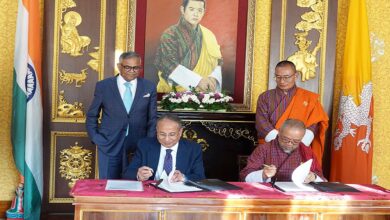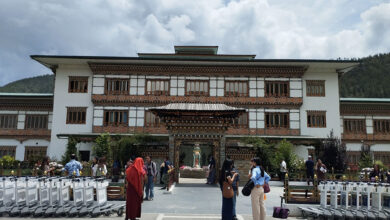Ministry in talks with Central Bank to lower lending rates: FM

By Thukten Zangpo
The finance ministry and the Royal Monetary Authority (RMA) are in talks to lower the lending rates, as directed by the Cabinet, finance minister, Lekey Dorji informed the National Assembly during the question-answer session yesterday.
He added that the RMA is also coming with a comprehensive monetary policy.
Questioning the minister on the high lending rates of financial institutions (FIs), Nanong-Shumar MP, Yeshey Jamtsho said that the bank’s lending rates have remained around 14 percent, while deposit rates have declined by more than three-quarters over the past two decades, resulting in substantial profits for FIs every year.
He added that the interest rate spread was at 7.8 percent in 2000, and has increased to about 11 percent. “Bhutan’s economy is serving the FIs rather than the FIs to the economy, leading to poor growth in the private sector, low savings and investment, and a high non-performing loans in banks.”
An interest rate spread is the difference between the interest rate charged by banks on loans and interest paid on deposits. A bigger interest rate spread means banks make more money from interest.
MP, Yeshey Jamtsho also questioned what measures the government had to address this situation, and its pledges related to interest-free and concessional loans for house construction, the purchase of power tillers and jersey cows.
Sharing the interest rate policy, Lyonpo Lekey Dorji said that in November 1997, the RMA mandated the FIs to maintain an interest rate spread of 6 percent. However, this was discontinued in April 1999.
Lyonpo added that the RMA also came with the benchmark reference of lending rate between 10 to 11 percent, however, the banks were lending at 14 to 15 percent.
He added that the weighted average deposit rate was between 4.35 percent to 4.75 percent in 2012. In August 2016, the RMA introduced the minimum lending rate (MLR) policy which has to be between 6 to 7 percent. Currently, the MLR is at 6.91 percent.
Lyonpo said that the introduction of the MLR saw a decline in the weighted average lending rate by 2 to 3 percent, which helped the economy.
With the weighted lending rate of 9.18 percent and weighted average deposit rate of 5.18 percent as of December last year, he added that the interest spread rate comes around 4 percent.
The MLR is determined by three parameters-marginal cost of funds, negative carry charges on cash reserve ratio, and operating cost of the banks. Adding these parameters, banks come up with the MLR, the average of which is considered the national MLR. The MLR is reviewed after every six months.
The final lending rate banks charge to clients takes into consideration the credit risk premium, which depends on credit worthiness of the banks, tenor risk and business strategies. These factors determine the profit margin of the banks.
The difference between the interest rates a bank pays to depositors and interest rate it receives from loans reflects the efficiency of the financial system in the country.
Lyonpo Lekey Dorji also said in the 13th Plan, the government’s priority is economic development and is working on providing concession loans and housing loans.
The 13th Plan has a provision to lower the lending rates by two to three percentage points.
For those constructing or buying a home or apartment for the first time, the government promised to support access to loans by loan-to-value (LTV) mortgage ratio from 70 percent to 95 percent at a reduced interest rate of 4 percent under the economic stimulus programme (ESP).
The government also pledged loan deferment support and introducing special loan schemes tailored for businesses that are yet to fully rebound from adverse impacts of the pandemic.
What bankers say
A banker said that the lower lending rate would be achievable only if the government injects liquidity in banks since the bank’s lending interest rate is determined by the MLR at 6.91 percent. “The bank would not be able to lend below MLR.”
He added that the lending rate depends on the deposit rate. “Depositors expect some interest to be paid and, when we pay more interest, we have to charge more interest on the clients.”
A banker also said that banks are currently facing a funding shortage or liquidity because of the ongoing loan deferment since last year. “Loan rate changes can impact bank’s liquidity, a decrease in loan rates due to a falling MLR could lead to higher loan demand and a need for increased deposits by FIs.”
With existing liquidity issues, a banker added that reducing loan rates would not make sense. However, lower loan rates might be considered during surplus liquidity, he added.
“If we have to give the loan interest rate at 4 percent, then the deposit rate has to be around zero percent.”
He added that the banks are expecting some changes in lending rate between 4 to 5 percent for certain priority sectors under the government’s ESP. However, there has been no discussion yet.
Currently, the Bank of Bhutan provides consumer loan at an interest rate of 8.55 percent, housing loan (commercial) at 8.93 percent, housing loan (non-commercial) at 8.13 percent, trade and commerce (wholesale and retail) at 11.14 percent, education loan between 8.13 percent to 9.90 percent, agriculture term loan at 8.32 percent, and agriculture working capital loan at 9.37 percent.
The Bank of Bhutan and Bhutan National Bank provides a deposit rate at 4.5 percent per annum for the savings deposit account.
For fixed deposits, two years to less than three years, the rate is 7 percent and it increases depending on the term.
As of March, this year, the credit in production and manufacturing stood at Nu 23.6 billion, hotel and tourism sector at Nu 27.6 billion, trade and commerce at Nu 17.5 billion, housing sector at Nu 65 billion, and service sector at Nu 18 billion.




